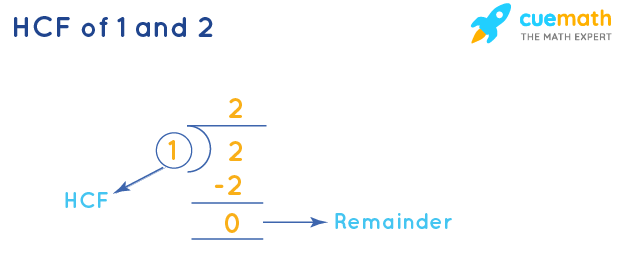HCF of 1 and 2
HCF of 1 and 2 is the largest possible number that divides 1 and 2 exactly without any remainder. The factors of 1 and 2 are (1) and (1, 2) respectively. The commonly used methods to find the HCF of 1 and 2 are - long division, Euclidean algorithm, and listing common factors.
| 1. | HCF of 1 and 2 |
| 2. | List of Methods |
| 3. | Solved Examples |
| 4. | FAQs |
What is HCF of 1 and 2?
Answer: HCF of 1 and 2 is 1.

Explanation:
The HCF of two non-zero integers, x(1) and y(2), is the highest positive integer m(1) that divides both x(1) and y(2) without any remainder.
Methods to Find HCF of 1 and 2
The methods to find the HCF of 1 and 2 are explained below.
- Long Division Method
- Listing Common Factors
- Using Euclid's Algorithm
HCF of 1 and 2 by Long Division

HCF of 1 and 2 is the divisor that we get when the remainder becomes 0 after doing long division.
- Step 1: Divide 2 (larger number) by 1 (smaller number).
- Step 2: Since the remainder = 0, the divisor (1) is the HCF of 1 and 2.
The corresponding divisor (1) is the HCF of 1 and 2.
HCF of 1 and 2 by Listing Common Factors
- Factor of 1: 1
- Factors of 2: 1, 2
Since 1 is the only common factor between 1 and 2. The highest common factor of 1 and 2 is 1.
HCF of 1 and 2 by Euclidean Algorithm
As per the Euclidean Algorithm, HCF(X, Y) = HCF(Y, X mod Y)
where X > Y and mod is the modulo operator.
Here X = 2 and Y = 1
- HCF(2, 1) = HCF(1, 2 mod 1) = HCF(1, 0)
- HCF(1, 0) = 1 (∵ HCF(X, 0) = |X|, where X ≠ 0)
Therefore, the value of HCF of 1 and 2 is 1.
☛ Also Check:
- HCF of 70, 105 and 175 = 35
- HCF of 306 and 657 = 9
- HCF of 2 and 3 = 1
- HCF of 4 and 6 = 2
- HCF of 0 and 6 = 6
- HCF of 32 and 40 = 8
- HCF of 20 and 30 = 10
HCF of 1 and 2 Examples
-
Example 1: Find the highest number that divides 1 and 2 exactly.
Solution:
The highest number that divides 1 and 2 exactly is their highest common factor, i.e. HCF of 1 and 2.
⇒ Factors of 1 and 2:- Factors of 1 = 1
- Factors of 2 = 1, 2
Therefore, the HCF of 1 and 2 is 1.
-
Example 2: The product of two numbers is 2. If their HCF is 1, what is their LCM?
Solution:
Given: HCF = 1 and product of numbers = 2
∵ LCM × HCF = product of numbers
⇒ LCM = Product/HCF = 2/1
Therefore, the LCM is 2. -
Example 3: Find the HCF of 1 and 2, if their LCM is 2.
Solution:
∵ LCM × HCF = 1 × 2
⇒ HCF(1, 2) = (1 × 2)/2 = 1
Therefore, the highest common factor of 1 and 2 is 1.

FAQs on HCF of 1 and 2
What is the HCF of 1 and 2?
The HCF of 1 and 2 is 1. To calculate the Highest common factor (HCF) of 1 and 2, we need to factor each number (factor of 1 = 1; factors of 2 = 1, 2) and choose the highest factor that exactly divides both 1 and 2, i.e., 1.
What are the Methods to Find HCF of 1 and 2?
There are three commonly used methods to find the HCF of 1 and 2.
- By Euclidean Algorithm
- By Long Division
- By Listing Common Factors
How to Find the HCF of 1 and 2 by Long Division Method?
To find the HCF of 1, 2 using long division method, 2 is divided by 1. The corresponding divisor (1) when remainder equals 0 is taken as HCF.
If the HCF of 2 and 1 is 1, Find its LCM.
HCF(2, 1) × LCM(2, 1) = 2 × 1
Since the HCF of 2 and 1 = 1
⇒ 1 × LCM(2, 1) = 2
Therefore, LCM = 2
☛ Highest Common Factor Calculator
What is the Relation Between LCM and HCF of 1, 2?
The following equation can be used to express the relation between LCM (Least Common Multiple) and HCF of 1 and 2, i.e. HCF × LCM = 1 × 2.
visual curriculum
